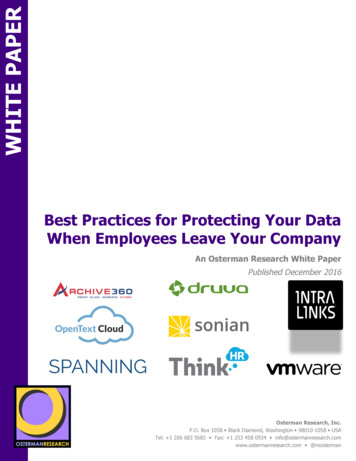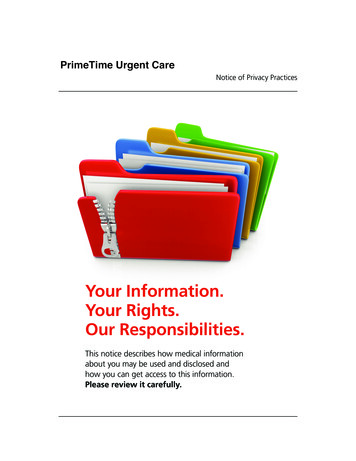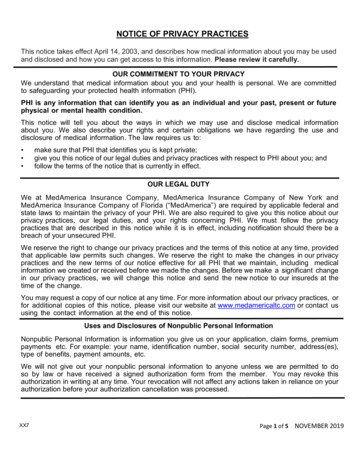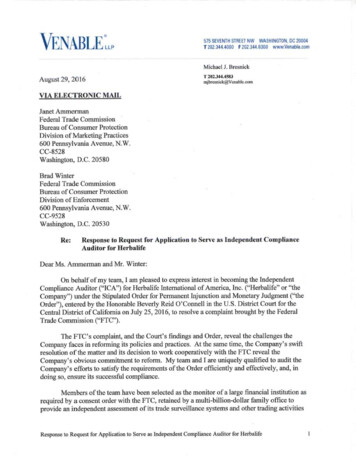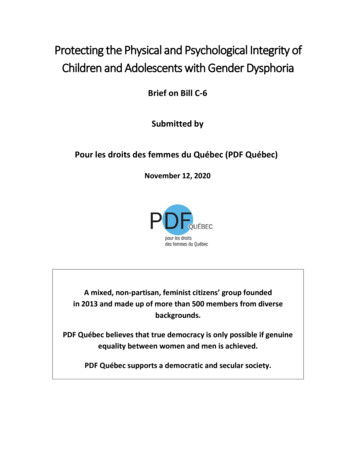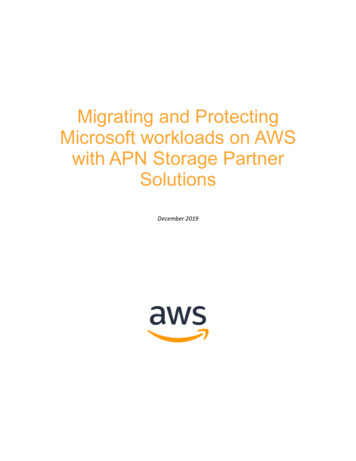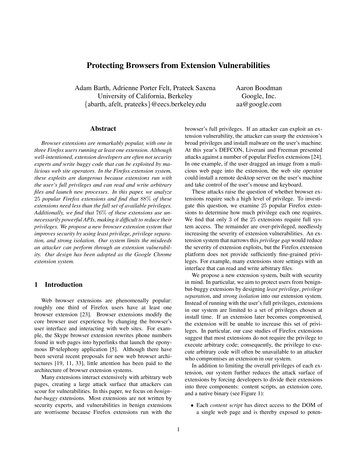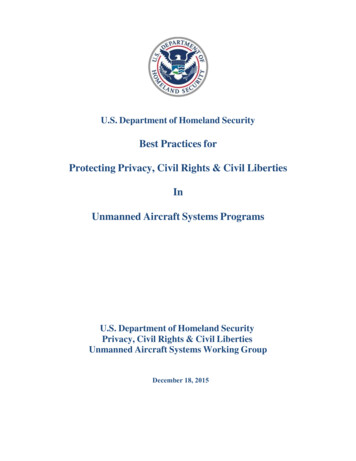
Transcription
U.S. Department of Homeland SecurityBest Practices forProtecting Privacy, Civil Rights & Civil LibertiesInUnmanned Aircraft Systems ProgramsU.S. Department of Homeland SecurityPrivacy, Civil Rights & Civil LibertiesUnmanned Aircraft Systems Working GroupDecember 18, 2015
Joint StatementCo-ChairsDepartment of Homeland SecurityPrivacy, Civil Rights & Civil LibertiesUnmanned Aircraft Systems Working GroupAs co-chairs of the Department of Homeland Security’s (DHS) Privacy, Civil Rights & CivilLiberties Unmanned Aircraft Systems Working Group (DHS Working Group), we are pleased topresent these best practices, which reflect DHS’ experiences in building unmanned aircraftsystem programs founded on strong privacy, civil rights, and civil liberties protections.Unmanned aircraft systems are an essential tool in DHS’s border security mission and present agreat deal of promise for assisting first responders and improving situational awareness.These best practices represent an optimal approach to protecting individual rights that isinfluenced by U.S. Customs and Border Protection’s (CBP) ten years of experience usingunmanned aircraft systems as a tool in protecting and securing the Nation’s borders. We aresharing these reflections broadly, recognizing that government entities (including CBP) havevarious limitations based upon their respective missions, operating characteristics, and legalauthorities, and that many of the considerations that apply to our agency may not be applicableor appropriate for other entities. The DHS Working Group neither proposes nor intends that thisdocument regulate any other government entity. Our goal, rather, is simply to share the bestpractices we have identified as helping to sustain privacy, civil rights, and civil libertiesthroughout the lifecycle of an unmanned aircraft systems program.1We provide these best practices to share DHS’s view of how to protect individual rights in thisevolving technology-driven field. The rapid changes in technology compel legal, privacy, andcivil rights and civil liberties experts to continually review and update implementing documents(e.g., best practices, standard operating procedures, and policies) to properly reflect changes inthe law, as well as advances in the technology and new applications of the technology. It isimportant for government entities to ensure that technology is not used in a manner that erodes orviolates an individual’s statutory or constitutional rights.1This guidance is intended for first responders (e.g., emergency management, emergency medical service, firedepartments, and security professionals responding to disasters and other emergencies), and does not seek to provideguidance in regard to investigative use of unmanned aircraft systems. DHS’s primary experience with UASoperations, which serves as the basis for these best practices, has come in the context of general border surveillanceoperations.1
Finally, even though these best practices are intended for DHS and our local, state, and federalgovernment partners and grantees, the private sector may also find these recommendationsvaluable and instructive in creating their unmanned aircraft system programs.Sincerely,2
U.S. Department of Homeland SecurityBest Practices forProtecting Privacy, Civil Rights & Civil LibertiesInUnmanned Aircraft Systems ProgramsOverviewThe term “unmanned aircraft systems” is used to define an unmanned aircraft and associatedelements (including communication links and the components that control the unmannedaircraft) that are required for the pilot or system operator in command to operate safely andefficiently in the national airspace system.1 In the past, unmanned aircraft were referred to as“unmanned aerial vehicles,” but today they are simply referred to as unmanned aircraft.Unmanned aircraft systems offer a variety of benefits for protecting our borders; supporting lawenforcement; assisting in search and rescue operations; locating forest fire hot spots; evaluatingdangerous environments (e.g., post-chemical spill and radiological exposure); conducting forensicimagery; inspecting pipeline and utilities; monitoring evacuation routes; and relayingtelecommunication signals.2The development of a new technology, significant improvement of a current technology, or the newapplication of an existing technology often results in concerns about the impact on individualprivacy, civil rights, and civil liberties. For instance, the integration of government and commercialunmanned aircraft systems into the National Airspace System by 2015, as required by the FederalAviation Administration Modernization and Reform Act of 2012, has prompted questions about howthis might impact individual rights.3In this regard, the Acting Officer for Civil Rights and Civil Liberties, the Acting Chief PrivacyOfficer, and the Assistant Commissioner for U.S. Customs and Border Protection, Office of Airand Marine jointly established the DHS Unmanned Aircraft Systems Privacy, Civil Rights andCivil Liberties Working Group (DHS Working Group) in September 2012 to “provide leadershipto the homeland security enterprise by clarifying the privacy, civil rights, and civil liberties legaland policy issues surrounding government use of [Unmanned Aircraft Systems].”41FAA Modernization and Reform Act of 2012, Pub. L. No.112-95.Government Accountability Office, Unmanned Aircraft Systems: Measuring Progress and Addressing PotentialPrivacy Concerns Would Facilitate Integration into the National Airspace System, p. 10, GAO-12-981 (September2012).3Id. at 2-3, 32-36.4Memorandum for the Secretary, Working Group to Safeguard Privacy, Civil Rights, and Civil Liberties in theDepartment’s Use and Support of Unmanned Aerial Systems (UAS), from Tamara J. Kessler, Acting Officer, Officefor Civil Rights and Civil Liberties; and Jonathan R. Cantor, Acting Chief Privacy Officer (September 12, 2012).The DHS Unmanned Aircraft Systems Privacy, Civil Rights and Civil Liberties Working Group, co-chaired by theDHS Office for Civil Rights & Civil Liberties, DHS Privacy Office and U.S. Customs and Border Protection, iscomprised of policy and operational subject matter experts from across DHS including the U.S. Coast Guard, Officeof Intelligence and Analysis, Office of the General Counsel, Office of Policy, National Protection and Programs23
The DHS Working Group publishes these best practices to inform DHS and our local, state, andfederal government partners and grantees that want to establish unmanned aircraft programsbased on policies and procedures that are respectful of privacy, civil rights, and civil liberties.These best practices are also consistent with the February 15, 2015 Presidential Memorandum:Promoting Economic Competitiveness while Safeguarding Privacy, Civil Rights, and CivilLiberties in Domestic Use of Unmanned Aircraft Systems.5Unmanned aircraft systems programs are encouraged to incorporate principles of transparencyand accountability, while not revealing information that could reasonably be expected tocompromise law enforcement or national security, and consider the issues that DHS hasencountered in the context of developing its own policies and programs.These best practices are not prescriptive, but rather are provided to share the Department’sconsiderable experience operating unmanned aircraft systems in securing the Nation’s bordersand supporting communities during natural disasters and emergencies, and to provide unmannedaircraft system operators with privacy, civil rights, and civil liberties practices to consider beforeinitiating an unmanned aircraft program. The applicability or advisability of implementing eachrecommended practice to a particular unmanned aircraft program will vary based upon eachindividual agency’s legal authorities, purpose of the mission, mission of the agency, type ofunmanned aircraft system, type of payload onboard, operating characteristics, and flight profiles.Therefore, each agency is encouraged to consult with its legal counsel to ensure compliance with itsagency’s own particular legal requirementsAlthough the intended audience is DHS and other government agencies, the private sector mayalso find these practices instructive in creating or operating unmanned aircraft programs.It is important that agencies work closely with legal, privacy, civil rights, and civil libertiesexperts to ensure compliance with applicable local, state, and federal laws and regulations whendeveloping an unmanned aircraft program.Directorate, Science &Technology Directorate, Federal Emergency Management Agency and the Office ofOperations Coordination and Planning.5Presidential Memorandum, Promoting Economic Competitiveness while Safeguarding Privacy, Civil Rights, andCivil Liberties in Domestic Use of Unmanned Aircraft Systems (2015). http://wh.gov/ibmmJ.4
Best Practices for ProtectingPrivacy, Civil Rights & Civil Liberties inUnmanned Aircraft Systems Programs1.Consult Your Legal Counsel, Privacy, Civil Rights, and Civil Liberties Experts toEnsure Legal Authority and CompliancePrior to establishing an unmanned aircraft program, work closely with your legal counsel toconfirm there is legal authority to operate unmanned aircraft systems for the intendedpurpose and whether it is permissible to fly unmanned aircraft in the desired area. Involvelegal, privacy, civil rights, and civil liberties experts at every stage of formulation,operation, and review of an unmanned aircraft program to ensure compliance withapplicable laws and policies.2.Clearly State the Purpose of the Unmanned Aircraft ProgramClearly articulate the primary purpose for establishing the unmanned aircraft systemsprogram.Considerations: The public may better understand and appreciate an agency’s reasons for establishingan unmanned aircraft program with a clearly stated and plainly worded purpose. Identify the challenge that prompted your agency to create an unmanned aircraftprogram and how unmanned aircraft systems will assist in addressing that challenge. Determine the appropriate payload(s) (e.g., infrared camera, video, radar) for eachstated purpose. Describe the primary purpose(s) of your unmanned aircraft program online and/ormake this information publicly accessible, while not revealing information that couldreasonably be expected to compromise law enforcement or national security.3.Stay Focused on the Purpose of the Unmanned Aircraft ProgramRecognizing that the purpose and utility of a UAS program may evolve over time, certainchanges to the unmanned aircraft program’s stated purpose that may impact individualrights should be reviewed by an agency’s legal, privacy, civil rights and civil libertiesexperts.Consideration: Changes to the unmanned aircraft program’s primary purposes should be reflected indocuments readily available to the public prior to implementing those changes (iffeasible).4.5.Designate an Individual Responsible for Privacy, Civil Rights, and Civil LibertiesComplianceThis should be a senior level individual within the organization, preferably in the office(s)responsible for privacy, civil rights and civil liberties (if one exists), with workingknowledge of the relevant privacy, civil rights, and civil liberties laws and regulations. Thesenior level individual should have a “direct line” to the person who has overallresponsibility for the unmanned aircraft program.Stay Involved from Conception Throughout Deployment and Thereafter5
Program managers, technical staff, and operations staff should consult with legal, privacy,civil rights, and civil liberties experts throughout the lifecycle of the unmanned aircraftprogram.Considerations: Establish and make publicly available clear policies and procedures to ensure respectfor privacy, civil rights, and civil liberties while also making it clear that someinformation may not be able to be made publicly available based upon other legal,investigative or operational security reasons. Unmanned aircraft program managers should consult with legal, privacy, civil rights,and civil liberties experts when formulating concepts of operations, standardoperating procedures, agreements, procurement contracts, and other underlyingunmanned aircraft system documents. Establish a routine program review process to assess whether the program’s purposeis being met and whether modifications are required. For example, the PresidentialMemorandum: Promoting Economic Competitiveness while Safeguarding Privacy,Civil Rights, and Civil Liberties in Domestic Use of Unmanned Aircraft Systemsrequires federal agencies to perform such an assessment at least every three years andbefore new UAS programs are developed.6.Conduct a Privacy Impact Assessment and Document Privacy ComplianceAgencies should conduct an analysis of potential privacy, civil rights, and civil libertiesconcerns before using unmanned aircraft systems. The Presidential Memorandum(referenced above) requires that Federal agencies examine their existing UAS policies andprocedures relating to the collection, use, retention, and dissemination of informationobtained by UAS at least every three years, to ensure that privacy, civil rights, and civilliberties are protected. Although not required for all agencies, DHS found it useful to use aPrivacy Impact Assessment (PIA) format for its examination—similar to that required forfederal government information technologies under the E-Government Act of 2002. Privacyassessments are beneficial in evaluating an agency’s compliance with applicable legal,regulatory, and policy requirements. The decision as to when such an assessment isappropriate will be a contextual decision for agencies to make based on their expertise, andthe facts and circumstances involved. Any privacy assessment should identify potentialrisks to privacy, as well as steps an agency will take to mitigate any potential privacy risks.DHS has also found the PIA format useful for public notification of its UAS activities. Formore information on the PIA format used by DHS (and to consult DHS PIAs that coverboth unmanned aircraft systems and the use of sensors by aircraft) please visit the DHSPrivacy Office webpage, available at ns: Some agencies conduct a brief Privacy Threshold Analysis to determine whether anyPersonally Identifiable Information2 is to be collected or whether an unmanned2DHS defines “Personally Identifiable Information” as any information that permits the identity of an individual tobe directly or indirectly inferred, including any information that is linked or linkable to that individual, regardless ofwhether the individual is a U.S. citizen, legal permanent resident, visitor to the U.S., or employee or contractor tothe Department.6
7.aircraft program raises privacy sensitivities before initiating a Privacy ImpactAssessment.Consult state, local, and tribal or territorial laws to decide if any public notice isrequired regarding the system used to store, use, or share information acquiredthrough unmanned aircraft systems. Federal agencies should consult the Privacy Actof 1974, as it may be applicable.Limit Collection, Use, Dissemination, and Retention of Unmanned Aircraft SystemRecorded DataCollection, use, dissemination, and retention of unmanned aircraft system-recorded datashould be limited to data legally acquired and relevant to the entity’s operations. See BestPractice #3.Considerations: Recorded images of individuals should not be retained beyond a reasonable period asdefined by existing agency/departmental policy unless there is authorization based ona legal, policy or operational purpose. Collection, use, dissemination, or retention of unmanned aircraft system-recordeddata should not be based solely on individual characteristics (e.g., race, ethnicity,national origin, sexual orientation, gender identity, religion, age, or gender), which isa violation of the law. The users of unmanned aircraft system-recorded data are responsible for ensuringdissemination of data is authorized and consistent with the recipients’ legitimate needto know and authority to receive such data; any further dissemination by a datarecipient should require the data owner’s prior consent, which should only beprovided upon the advice of the entity’s legal counsel. Federal agencies need to establish whether their systems collect and store PII, and ifso, whether there is an applicable System of Records Notice. Additionally, if theirsystem does collect and store PII, agencies should consider whether they should limitthe collection of personally identifiable information in accordance with OMB M 7-16,Safeguarding Against and Responding to the Breach of Personally IdentifiableInformation.3 Requests for unmanned aircraft system data by commercial entities, civil litigants, orFreedom of Information Act requesters should be reviewed by legal counsel todetermine if such sharing is appropriate and permissible under applicable laws orregulations. Unmanned aircraft program managers should employ reasonable technological oradministrative safeguards to ensure that images of people incidentally recorded whoare not relevant to an operation are not disseminated or viewed unnecessarily toprotect individual rights. This is especially important for recordingsthat includeimages of minors not relevant to an operation. Follow and clarify (if necessary) existing procedures for identifying, disseminating,retaining, indexing, and storing relevant and necessary unmanned aircraft systemrecorded data in a retrievable manner.3OMB M 7-16, Safeguarding Against and Responding to the Breach of Personally Identifiable Information les/omb/memoranda/fy2007/m07-16.pdf7
8.Establish or comply with an approved records retention schedule that systematicallyeliminates stored data after they are no longer legally required or operationally usefulif not already present, this schedule should be periodically reviewed and updated.Ensure retention periods are compatible with the type of data retained and needs ofthe unmanned aircraft program. Data collected that does not pertain to an authorizedpurpose should not be retained beyond 180 days.Respect Constitutionally Protected ActivitiesAt times, government agencies may find it necessary to deploy unmanned aircraft systemsto protect the public safety or respond to emergencies while other constitutionally protectedactivities may be taking place at the same location.Considerations: Incidental images of identifiable individuals that are recorded, but not needed for legalcompliance or law enforcement purposes, should be deleted according to establishedprocedures and within 180 days. Be attuned to the potential privacy risks or legal ramifications arising frominadvertently capturing images of individuals engaging in constitutionally protectedactivities, and establish appropriate guidelines and administrative controls toanonymize, destroy, safeguard or prevent the misuse of such data, consistent withapplicable law. Unmanned aircraft system-recorded data should not be collected, disseminated orretained solely for the purpose of monitoring activities protected by the U.S.Constitution, such as the First Amendment’s protections of religion, speech, press,assembly, and redress of grievances (e.g., protests, demonstrations).9.Have a Redress Program for Individuals that Covers Unmanned Aircraft SystemActivitiesA robust and streamlined redress program is essential for permitting challenges to allegedinappropriate capture of personally identifiable information. Ensure that adequateprocedures are in place to receive, investigate, and address, as appropriate, privacy, civilrights, and civil liberties complaints.Considerations: Where an administrative process is used, the process for resolving complaints shouldpromote resolution within a reasonable amount of time. When circumstances permit, and while not revealing in
Dec 18, 2015 · senior level individual should have a “direct line” to the person who has overall responsibility for the unmanned aircraft program. 5. Stay Invo
